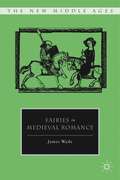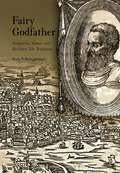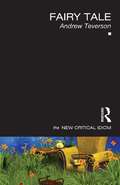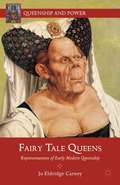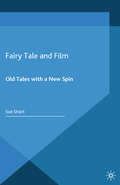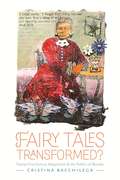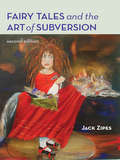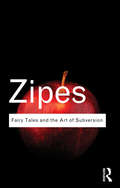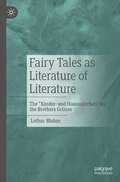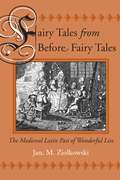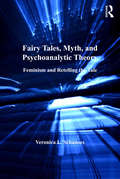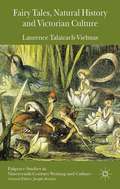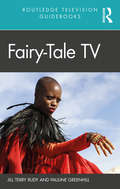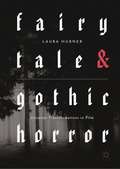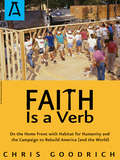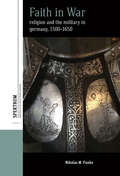- Table View
- List View
Fairies in Medieval Romance
by James WadeThis is the first book to construct a theoretical framework that not only introduces a new way of reading romance writing at large, but more specifically that generates useful critical readings of the specific functions of fairies in individual romance texts.
Fairness and Validation in Language Assessment: Selected papers from the 19th Language Testing Research Colloquium, Orlando, Florida (Studies in Language Testing #9)
by Antony John KunnanFairness of language tests and testing practices has always been a concern among test developers and test users. In the past decade educational and language assessment researchers have begun to focus directly on fairness and related matters such as test standards, test bias and equity and ethics for testing professionals. <p><p>The 19th annual Language Testing Research Colloquium held in 1997 in Orlando, Florida, brought this overall concern into sharp focus by having 'Fairness in Language Testing' as its theme. The conference presentations and discussions attempted to understand the concept of fairness, define the scope of the concept and connect it with the concept of validation of test score interpretation. The papers in this volume offer a first introduction to fairness and validation in the field of language assessment.
Fairness, Justice, and Language Assessment
by Tim McNamara Ute Knoch Oxford Editors Jason FanThis book has two goals, each related to the validity of language assessment. The first goal is to explore the difference between fairness and justice in language assessment. <p><p> The authors distinguish internal and external dimensions of the equitable and just treatment of individuals taking language tests which are used as gatekeeping devices to determine access to education and employment, immigrant status, citizenship, and other rights. <p><p> The second goal is to show how the extent of test fairness can be demonstrated and improved using the tools of psychometrics, in particular the models collectively known as Rasch measurement.
Fairy Godfather
by Ruth B. BottigheimerIn the classic rags-to-riches fairy tale a penniless heroine (or hero), with some magic help, marries a royal prince (or princess) and rises to wealth. Received opinion has long been that stories like these originated among peasants, who passed them along by word of mouth from one place to another over the course of centuries. In a bold departure from conventional fairy tale scholarship, Ruth B. Bottigheimer asserts that city life and a single individual played a central role in the creation and transmission of many of these familiar tales. According to her, a provincial boy, Zoan Francesco Straparola, went to Venice to seek his fortune and found it by inventing the modern fairy tale, including the long beloved Puss in Boots, and by selling its many versions to the hopeful inhabitants of that colorful and commercially bustling city.With innovative literary sleuthing, Bottigheimer has reconstructed the actual composition of Straparola's collection of tales. Grounding her work in social history of the Renaissance Venice, Bottigheimer has created a possible biography for Straparola, a man about whom hardly anything is known. This is the first book-length study of Straparola in any language.
Fairy Tale (The New Critical Idiom)
by Andrew TeversonThis volume offers a comprehensive critical and theoretical introduction to the genre of the fairy tale. It: explores the ways in which folklorists have defined the genre assesses the various methodologies used in the analysis and interpretation of fairy tale provides a detailed account of the historical development of the fairy tale as a literary form engages with the major ideological controversies that have shaped critical and creative approaches to fairy tales in the twentieth and twenty-first centuries demonstrates that the fairy tale is a highly metamorphic genre that has flourished in diverse media, including oral tradition, literature, film, and the visual arts.
Fairy Tale Queens
by Jo Eldridge CarneyMost of today's familiar fairy tales come from the stories of Charles Perrault, the Brothers Grimm, and Hans Christian Andersen, but this innovative study encourages us to explore the marvelous tales of authors from the early modern period Giovanni Straparola, Giambattista Basile, Madame Marie-Catherine D'Aulnoy, and others whose works enrich and expand the canon. As author Jo Eldridge Carney shows, the queen is omnipresent in these stories, as much a hallmark of the genre as other familiar characteristics such as the number three, magical objects, and happy endings. That queens occupy such space in early modern tales is not surprising given the profound influence of so many powerful queens in the political landscapes of early modern England and Europe. Carney makes a powerful argument for the historical relevance of fairy tales and, by exploring the dynamic intersection between fictional and actual queens, shows how history and folk literature mutually enrich our understanding of the period.
Fairy Tale and Film: Old Tales with a New Spin
by S. ShortSue Short examines how fairy tale tropes have been reworked in contemporary film, identifying familiar themes in a range of genres – including rom coms, crime films and horror – and noting key similarities and differences between the source narratives and their offspring.
Fairy Tales Transformed?: Twenty-First-Century Adaptations and the Politics of Wonder
by Cristina BacchilegaFairy-tale adaptations are ubiquitous in modern popular culture, but readers and scholars alike may take for granted the many voices and traditions folded into today's tales. In Fairy Tales Transformed?: Twenty-First-Century Adaptations and the Politics of Wonder, accomplished fairy-tale scholar Cristina Bacchilega traces what she terms a "fairy-tale web" of multivocal influences in modern adaptations, asking how tales have been changed by and for the early twenty-first century. Dealing mainly with literary and cinematic adaptations for adults and young adults, Bacchilega investigates the linked and yet divergent social projects these fairy tales imagine, their participation and competition in multiple genre and media systems, and their relation to a politics of wonder that contests a naturalized hierarchy of Euro-American literary fairy tale over folktale and other wonder genres. Bacchilega begins by assessing changes in contemporary understandings and adaptations of the Euro-American fairy tale since the 1970s, and introduces the fairy-tale web as a network of reading and writing practices with a long history shaped by forces of gender politics, capitalism, and colonialism. In the chapters that follow, Bacchilega considers a range of texts, from high profile films like Disney's Enchanted, Guillermo del Toro's Pan's Labyrinth, and Catherine Breillat's Bluebeard to literary adaptations like Nalo Hopkinson's Skin Folk, Emma Donoghue's Kissing the Witch, and Bill Willingham's popular comics series, Fables. She looks at the fairy-tale web from a number of approaches, including adaptation as "activist response" in Chapter 1, as remediation within convergence culture in Chapter 2, and a space of genre mixing in Chapter 3. Chapter 4 connects adaptation with issues of translation and stereotyping to discuss mainstream North American adaptations of The Arabian Nights as "media text" in post-9/11 globalized culture. Bacchilega's epilogue invites scholars to intensify their attention to multimedia fairy-tale traditions and the relationship of folk and fairy tales with other cultures' wonder genres. Scholars of fairy-tale studies will enjoy Bacchilega's significant new study of contemporary adaptations.
Fairy Tales and Fables from Weimar Days
by Jack ZipesThis book is a collection of traditional German fairy tales and fables, deliberately transformed into utopian narratives and social commentary by political activists in the Weimar Republic (1919-1933). Against a backdrop of financial and political instability, widespread homelessness, and the reformation of public institutions, numerous gifted writers such as Berta Lask, Kurt Schwitters, Hermynia zur Mühlen, Oskar Maria Graf, Bruno Schönlank, and Joachim Ringelnatz responded to the need for hope among the common people by creating fairy tales and fables that offered a new and critical vision of social conditions. Though many of their tales deal with the grim situation of common people and their apparent helplessness, they are founded on the principle of hope. This revised edition includes over 50 illustrations by contemporary international artists who reveal how similar the Weimar conditions were to the conditions in which we presently live. In this respect, the Weimar fairy tales and fables have not lost their spirit and significance.
Fairy Tales and the Art of Subversion: The Classical Genre For Children And The Process Of Civilization (Routledge Classics Ser.)
by Jack ZipesThe fairy tale may be one of the most important cultural and social influences on children's lives. But until Fairy Tales and the Art of Subversion, little attention had been paid to the ways in which the writers and collectors of tales used traditional forms and genres in order to shape children's lives – their behavior, values, and relationship to society. As Jack Zipes convincingly shows, fairy tales have always been a powerful discourse, capable of being used to shape or destabilize attitudes and behavior within culture.For this new edition, the author has revised the work throughout and added a new introduction bringing this classic title up to date.
Fairy Tales and the Art of Subversion: The Classical Genre For Children And The Process Of Civilization (Routledge Classics)
by Jack ZipesThe fairy tale is arguably one of the most important cultural and social influences on children's lives. But until the first publication of Fairy Tales and the Art of Subversion, little attention had been paid to the ways in which the writers and collectors of tales used traditional forms and genres in order to shape children's lives – their behavior, values, and relationship to society. As Jack Zipes convincingly shows in this classic work, fairy tales have always been a powerful discourse, capable of being used to shape or destabilize attitudes and behavior within culture. How and why did certain authors try to influence children or social images of children? How were fairy tales shaped by the changes in European society in the sixteenth and seventeenth centuries? Zipes examines famous writers of fairy tales such as Charles Perrault, Jacob and Wilhelm Grimm, Hans Christian Andersen and L.Frank Baum and considers the extraordinary impact of Walt Disney on the genre as a fairy tale filmmaker.
Fairy Tales as Literature of Literature: The "Kinder- und Hausmärchen" by the Brothers Grimm
by Lothar BluhmIn this study, the Brothers Grimm's fairy tales are consistently examined as literature out of literature. Through the history of their creation and transformation, it becomes apparent how literary models were re-declared and transformed into the well-known fairy tale narratives, in the course of the editing process by the Brothers Grimm, essentially by Wilhelm Grimm. By means of a series of model studies – including Rapunzel, Jorinde und Joringel and Der Jude im Dorn – it is shown that the Brothers Grimm's fairy tales, contrary to their traditional assessment as 'folk tales', are of literary origin and have a literary character themselves.
Fairy Tales from Before Fairy Tales: The Medieval Latin Past of Wonderful Lies
by Jan M. ZiolkowskiWhen did fairy tales begin? What qualifies as a fairy tale? Is a true fairy tale oral or literary? Or is a fairy tale determined not by style but by content? To answer these and other questions, Jan M. Ziolkowski not only provides a comprehensive overview of the theoretical debates about fairy tale origins but includes an extensive discussion of the relationship of the fairy tale to both the written and oral sources. Ziolkowski offers interpretations of a sampling of the tales in order to sketch the complex connections that existed in the Middle Ages between oral folktales and their written equivalents, the variety of uses to which the writers applied the stories, and the diverse relationships between the medieval texts and the expressions of the same tales in the "classic" fairy tale collections of the nineteenth century. In so doing, Ziolkowski explores stories that survive in both versions associated with, on the one hand, such standards of the nineteenth-century fairy tale as the Brothers Grimm, Hans Christian Andersen, and Carlo Collodi and, on the other, medieval Latin, demonstrating that the literary fairy tale owes a great debt to the Latin literature of the medieval period. Jan M. Ziolkowski is the Arthur Kingsley Porter Professor of Medieval Latin at Harvard University.
Fairy Tales on the Teen Screen
by Athena BellasThis book examines how the fairy tale is currently being redeployed and revised on the contemporary teen screen. The author redeploys Victor Turner's work on liminality for a feminist agenda, providing a new and productive method for thinking about girlhood onscreen. While many studies of teenagehood and teen film briefly invoke Turner's concept, it remains an underdeveloped framework for thinking about youth onscreen. The book's broad scope across teen media--including film, television, and online media--contributes to the need for contemporary analysis and theorisation of our multimedia cultural climate.
Fairy Tales, Myth, and Psychoanalytic Theory: Feminism and Retelling the Tale (Ashgate Studies In Childhood, 1700 To The Present Ser.)
by Veronica L. SchanoesAt the same time that 1970s feminist psychoanalytic theorists like Jean Baker Miller and Nancy Chodorow were challenging earlier models that assumed the masculine psyche as the norm for human development and mental/emotional health, writers such as Anne Sexton, Olga Broumass, and Angela Carter were embarked on their own revisionist project to breathe new life into fairy tales and classical myths based on traditional gender roles. Similarly, in the 1990s, second-wave feminist clinicians continued the work begun by Chodorow and Miller, while writers of fantasy that include Terry Windling, Tanith Lee, Terry Pratchett, and Catherynne M. Valente took their inspiration from revisionist authors of the 1970s. As Schanoes shows, these two decades were both particularly fruitful eras for artists and psychoanalytic theorists concerned with issues related to the development of women's sense of self. Putting aside the limitations of both strains of feminist psychoanalytic theory, their influence is undeniable. Schanoes's book posits a new model for understanding both feminist psychoanalytic theory and feminist retellings, one that emphasizes the interdependence of theory and art and challenges the notion that literary revision involves a masculinist struggle with the writer's artistic forbearers.
Fairy Tales, Natural History and Victorian Culture
by Laurence Talairach-VielmasFairy Tales, Natural History and Victorian Culture examines how literary fairy tales were informed by natural historical knowledge in the Victorian period, as well as how popular science books used fairies to explain natural history at a time when 'nature' became a much debated word.
Fairy-Tale Films Beyond Disney: International Perspectives
by Jack Zipes Pauline Greenhill Kendra Magnus-JohnstonThe fairy tale has become one of the dominant cultural forms and genres internationally, thanks in large part to its many manifestations on screen. Yet the history and relevance of the fairy-tale film have largely been neglected. In this follow-up to Jack Zipes’s award-winning book The Enchanted Screen (2011), Fairy-Tale Films Beyond Disney offers the first book-length multinational, multidisciplinary exploration of fairy-tale cinema. Bringing together twenty-three of the world’s top fairy-tale scholars to analyze the enormous scope of these films, Zipes and colleagues Pauline Greenhill and Kendra Magnus-Johnston present perspectives on film from every part of the globe, from Hayao Miyazaki’s Spirited Away, to Jan Švankmajer’s Alice, to the transnational adaptations of 1001 Nights and Hans Christian Andersen. Contributors explore filmic traditions in each area not only from their different cultural backgrounds, but from a range of academic fields, including criminal justice studies, education, film studies, folkloristics, gender studies, and literary studies. Fairy-Tale Films Beyond Disney offers readers an opportunity to explore the intersections, disparities, historical and national contexts of its subject, and to further appreciate what has become an undeniably global phenomenon.
Fairy-Tale Revivals in the Long Nineteenth Century: Volume I: Fairy-Tale Revivals: Writing Wonder in Transatlantic Ethnic Literary Revivals, 1850–1950
by Abigail HeinigerThis collection opens with marginalized responses to the highly politicized Cinderella traditions in the Anglophone world. In the United States, Cinderella was incorporated into the gendered narrative of the American Dream and narratives of empire in the colonial world, particularly in the mid-1800s. Marginalized writers have responded to these nationalistic colonial traditions in two distinctive ways: clever Cinderellas who negotiate a broken system or passive Cinderellas who die as anti-heroes in disenchanting fairy tales. This dual tradition of marginalized Cinderellas is also apparent across the Anglophone world. Potential texts include the out-of-print works of Sinèad de Valera, excerpts from the novels of Hannah Crafts, Jessie Fauset, and Julia Kavanagh, along with dramas by Ann Devlin, and collected oral tales.
Fairy-Tale Revivals in the Long Nineteenth Century: Volume II: Fairy- Tale Revival Dramas: Writing Wonder in Transatlantic Ethnic Literary Revivals, 1850–1950
by Abigail HeinigerVolume two explores the way a wide range of classic princess tales written by marginalized writers. Rapunzel and Snow White, with their pale skin or long ropes of golden hair, are particularly popular vehicles for exploring and challenging racialized constructions of beauty. Marriage is the traditional vehicle of a happy ending in Princess tales, so marginalized responses to these tales also inherently respond to the doubly colonized position of women in the Anglophone world. The institution of marriage typically exposes the institutional oppression of colonized women. Authors include Charles Chesnutt, Jessie Fauset, Julia Kavanaugh, George Edwards, some of the unpublished manuscripts of Jewish-Australian author Joseph Jacobs, and the earliest work of Sinèad de Valera, as well as fin-de-siècle illustrators such as Harry Clarke, and collected oral tales.
Fairy-Tale Science
by Suzanne MagnaniniBetween 1550 and 1650, Europe was swept by a fascination with wondrous accounts of monsters and other marvels - of valiant men slaying dragons, women giving birth to animals, young girls growing penises, and all manner of fantastic phenomena. Known as 'fairy tales,' these stories had many guises and inhabited a variety of literary texts. The first two collections of such fairy tales published on the continent, Giovan Francesco Straparola's Le piacevoli notti and Giambattista Basile's Lo cunto de li cunti, were greeted with much enthusiasm at home and abroad and essentially established a new literary genre. Contrary to popular thought, Italy, not Germany or France, was the birthplace of the literary fairy tale.This fascination with the marvellous also extended to the worlds of science, medicine, philosophy, and religion, and many treatises from the period focused on discussions of monsters, demons, magic, and witchcraft. In Fairy-Tale Science Suzanne Magnanini looks at these 'science fictions' and explores the birth and evolution of the literary fairy tale in the context of early modern discourses on the monstrous. She demonstrates how both the normative literary theories of the Italian intellectual establishment and the emerging New Science limited the genre's success on its native soil. Natural philosophers, physicians, and clergymen positioned the fairy tale in opposition in opposition to science, fixing it as a negative pole in a binary system, one which came to define both a new type of scientific inquiry and the nascent literary genre. Magnanini also suggests that, by identifying their literary production with the monstrous and the feminine, Straparola and Basile contributed to the marginalization of the new genre.A wide-ranging yet carefully crafted study, Fairy-Tale Science investigates the complex interplay between scientific discourse and an emerging literary genre, and expands our understanding of the early modern European imagination.
Fairy-Tale TV (Routledge Television Guidebooks)
by Pauline Greenhill Jill Terry RudyThis concise and accessible critical introduction examines the world of popular fairy-tale television, tracing how fairy tales and their social and cultural implications manifest within series, television events, anthologies, and episodes, and as freestanding motifs. Providing a model of televisual analysis, Rudy and Greenhill emphasize that fairy-tale longevity in general, and particularly on TV, results from malleability—morphing from extremely complex narratives to the simple quotation of a name (like Cinderella) or phrase (like "happily ever after")—as well as its perennial value as a form that is good to think with. The global reach and popularity of fairy tales is reflected in the book’s selection of diverse examples from genres such as political, lifestyle, reality, and science fiction TV. With a select mediagraphy, discussion questions, and detailed bibliography for further study, this book is an ideal guide for students and scholars of television studies, popular culture, and media studies, as well as dedicated fairy-tale fans.
Fairytale and Gothic Horror: Uncanny Transformations in Film
by Laura HubnerThis book explores the idiosyncratic effects generated as fairytale and gothic horror join, clash or merge in cinema. Identifying long-held traditions that have inspired this topical phenomenon, the book features close analysis of classical through to contemporary films. It begins by tracing fairytale and gothic origins and evolutions, examining the diverse ways these have been embraced and developed by cinema horror. It moves on to investigate films close up, locating fairytale horror, motifs and themes and a distinctively cinematic gothic horror. At the book’s core are recurring concerns including: the boundaries of the human; rational and irrational forces; fears and dreams; ‘the uncanny’ and transitions between the wilds and civilization. While chronology shapes the book, it is thematically driven, with an interest in the cultural and political functions of fairytale and gothic horror, and the levels of transgression or social conformity at the heart of the films.
Faith Is a Verb: On the Home Front with Habitat for Humanity and the Campaign to Rebuild America (and the World)
by Chris GoodrichFaith is a Verb is both an account of the author's five years volunteering with Habitat for Humanity and a history of the organization, which Goodrich sees as a model institution founded on grassroots, Jeffersonian principles. The reader looks over his shoulder as Goodrich helps restore a burned-out drug den to its Victorian glory in Bridgeport, Connecticut; understands the yawning gap between the rich and poor as he straightens nails with an impoverished teenager in the Dominican Republic; senses the importance of volunteer work as he watches, while laying a stone foundation in Paraguay, the Twin Towers fall on 9/11.Goodrich traces Habitat's history back to an unsung American hero, Clarence Jordan, who in the 1940's founded a Christian community in Georgia, Koinonia Farm, dedicated to social and economic justice. Millard Fuller, a millionaire businessman, visited at Koinonia in the early 1970's, and under Jordan's guidance realized he was a "money-holic," gave away his fortune, and in 1976 founded Habitat for Humanity. Goodrich shows how Fuller's Southern Baptist, Friday-night-revival personality helped turn Habitat into the world's largest non-governmental home-builder, his inspirational leadership greatly abetted by the support of former president Jimmy Carter. In a postscript the author describes the crisis Habitat faced when Fuller was forced out following allegations of sexual harassment in 2005. This edition updates the story to 2013, when the organization had "helped build or repair more than 600,000 houses" world-wide.What readers have said about Faith is a Verb:"A great record of how [Habitat for Humanity] got underway and became so significant." -- Tony Campolo, PhD., author of Pray Give Go Do"[S]pirited and intimate....Anyone interested in learning about or volunteering for the organization will find his account richly detailed." -- David Bornstein, author of How to Change the World
Faith in Exposure: Privacy and Secularism in the Nineteenth-Century United States (Early American Studies)
by Justine S. MurisonRecent legal history in the United States reveals a hardening tendency to treat religious freedom and sexual and reproductive freedom as competing, even opposing, claims on public life. They are united, though, by the fact that both are rooted in our culture’s understanding of privacy. Faith in Exposure shows how, over the course of the nineteenth century, privacy came to encompass such contradictions—both underpinning the right to sexual and reproductive rights but also undermining them in the name of religious freedom.Drawing on the interdisciplinary field of secular studies, Faith in Exposure brings a postsecular orientation to the historical emergence of modern privacy. The book explains this emergence through two interlocking stories. The first examines the legal and cultural connection of religion with the private sphere, showing how privacy became a moral concept that informs how we debate the right to be shielded from state interference, as well as who will be afforded or denied this protection. This conflation of religion with privacy gave rise, the book argues, to a “secular sensibility” that was especially invested in authenticity and the exposure of hypocrisy in others.The second story examines the development of this “secular sensibility” of privacy through nineteenth-century novels. The preoccupation of the novel form with private life, and especially its dependence on revelations of private desire and sexual secrets, made it the perfect vehicle for suggesting that exposure might be synonymous with morality itself. Each chapter places key authors into wider contexts of popular fiction and periodical press debates. From fears over religious infidelity to controversies over what constituted a modern marriage and conspiracy theories about abolitionists, these were the contests, Justine S. Murison argues, that helped privacy emerge as both a sensibility and a right in modern, secular America.
Faith in War: Religion and the Military in Germany, c.1500-1650 (Spektrum: Publications of the German Studies Association #31)
by Nikolas M. FunkeWhile the social and cultural history of the early modern military has greatly advanced in the last few decades, the religious dimension of the military life in the Holy Roman Empire between 1500 and 1650 has hardly been explored. The Reformation brought profound political, social and cultural upheavals, but the religiosity of the men and women who followed the Christian life in the chaos of war still represents a large gap in the historiography. Faith in War shows that confessional antagonisms lost much of their meaning during war and coexistence became a fact of army life. Connecting military and civilian social and cultural history in these ways, Nikolas Funke’s case study on this period brings new life to important current historiographical discussions in a military context, including stereotyping, confessionalization, social discipline, deviance, toleration, religious violence, and the culture of death.
